Презентация presentation-cp10-eng

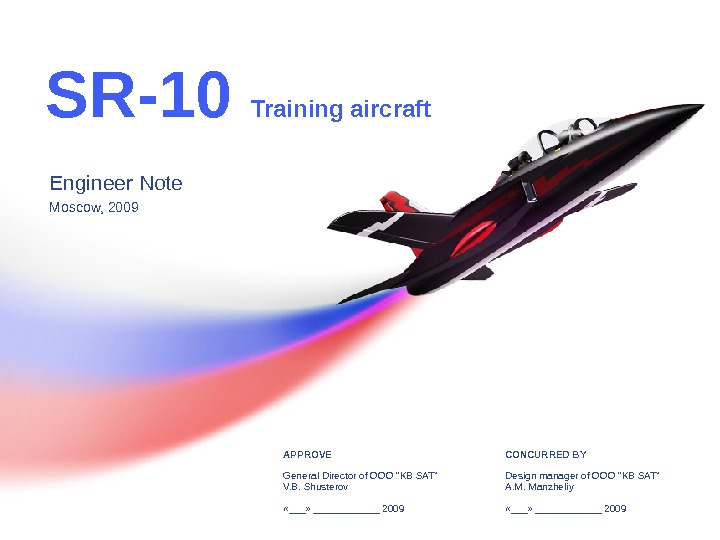
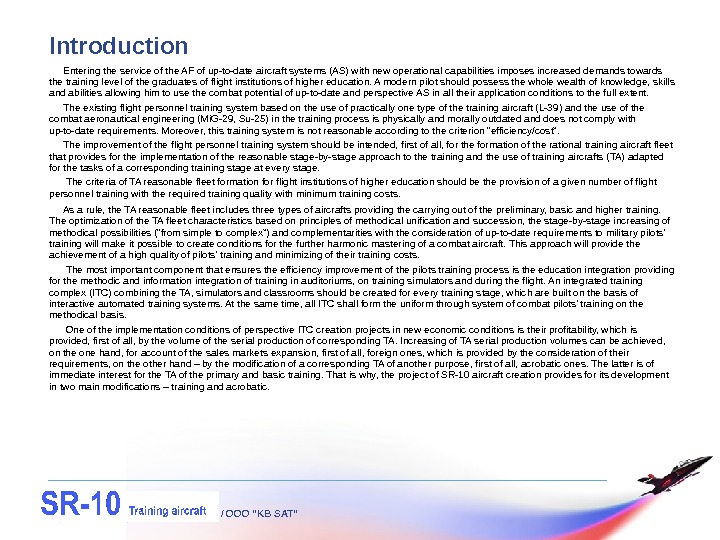
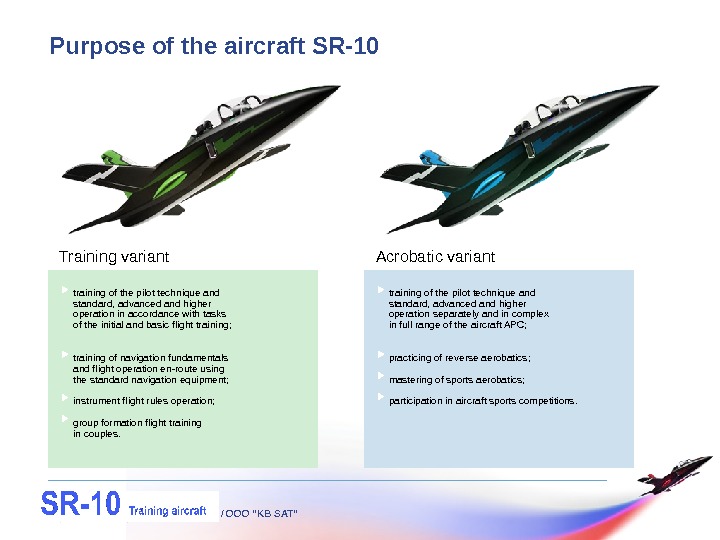
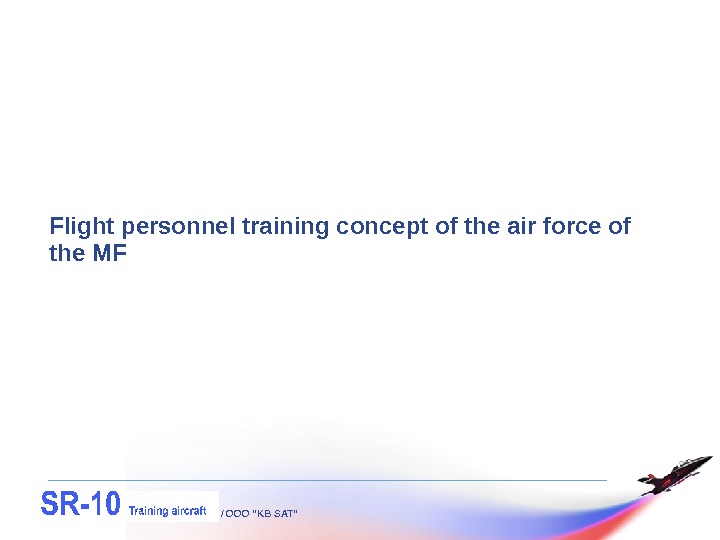
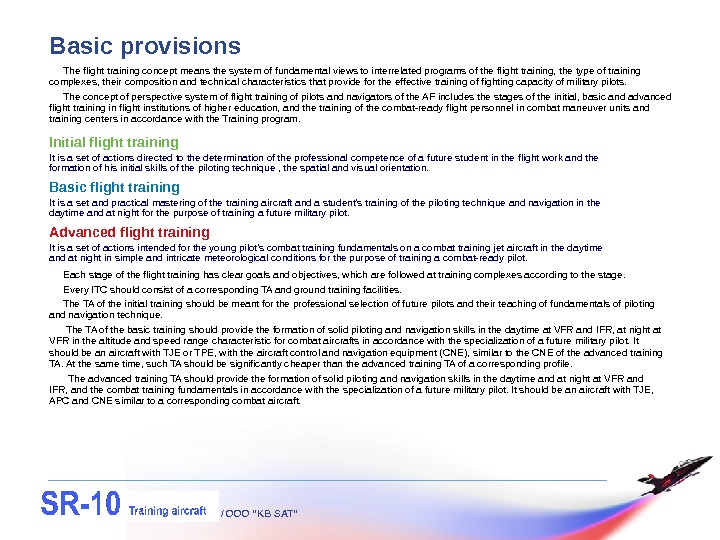
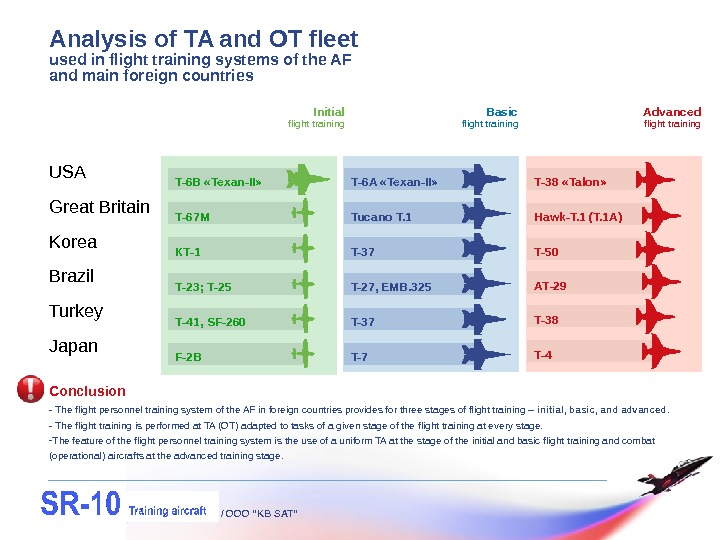
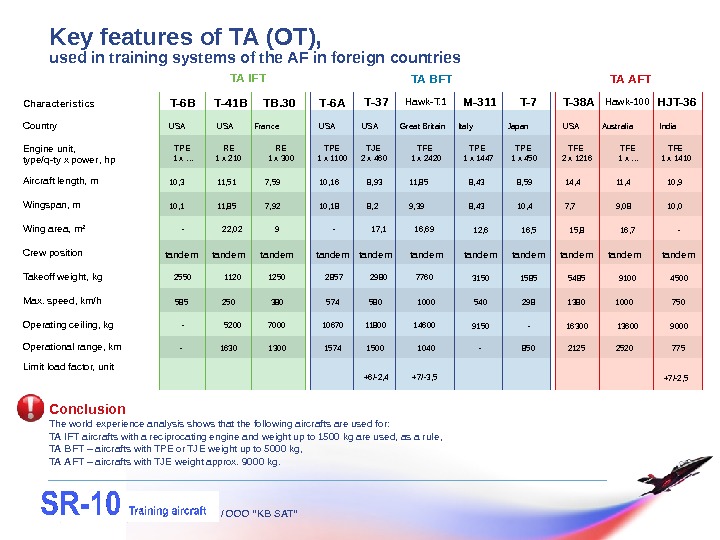
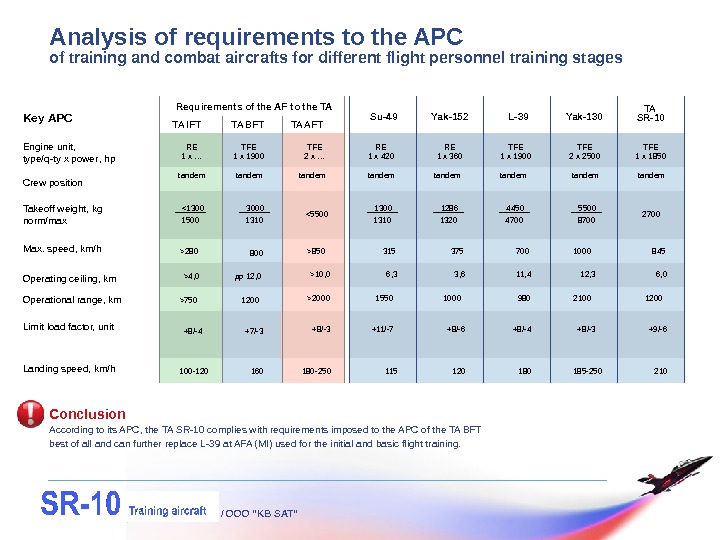
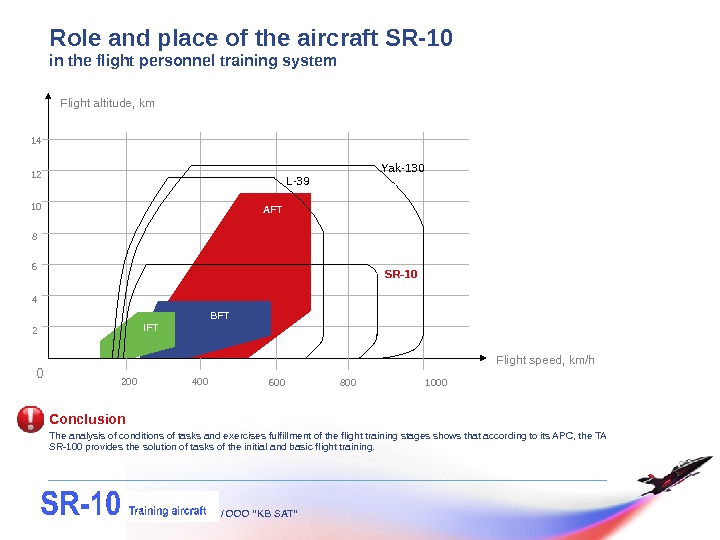
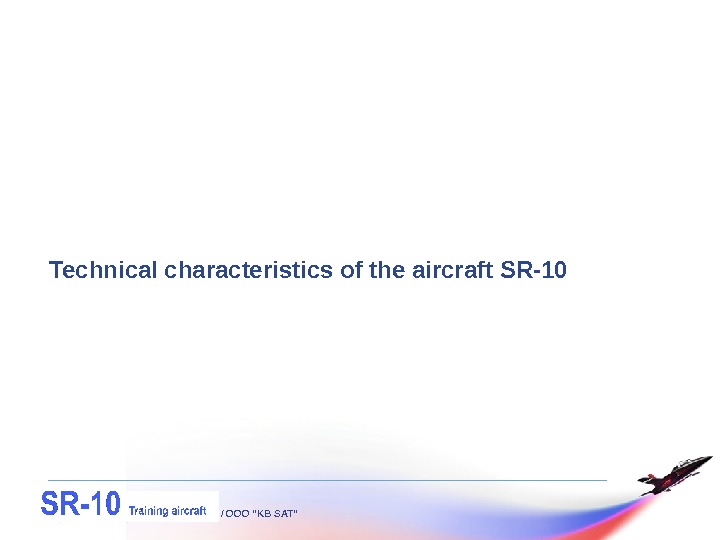
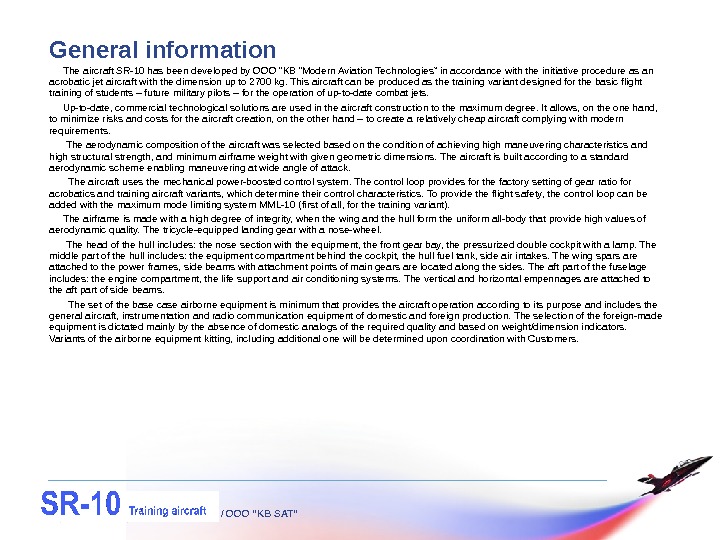
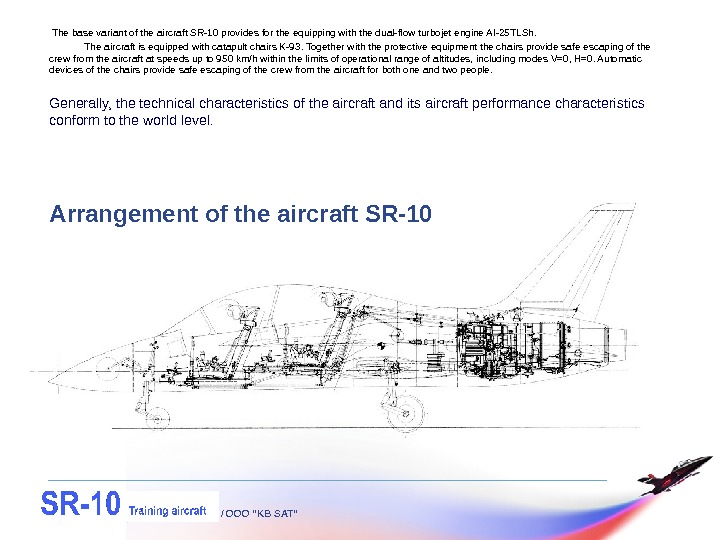
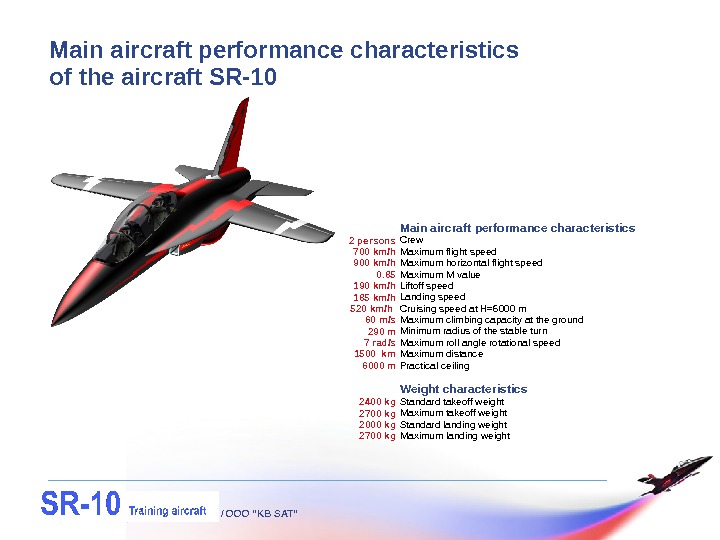
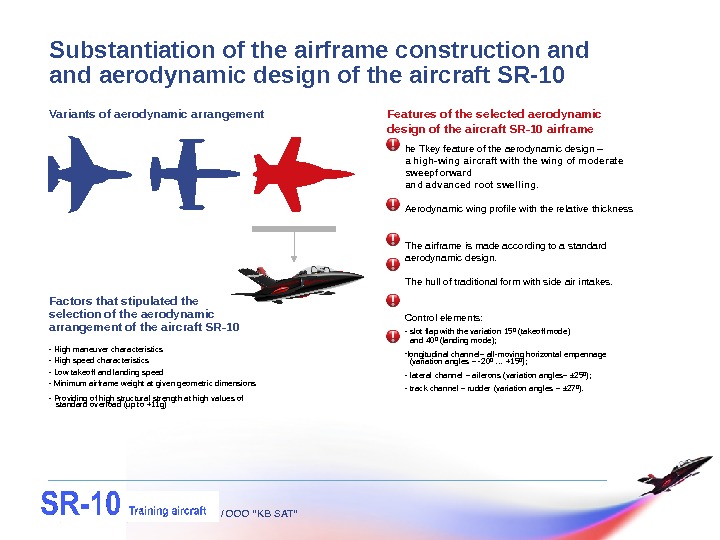
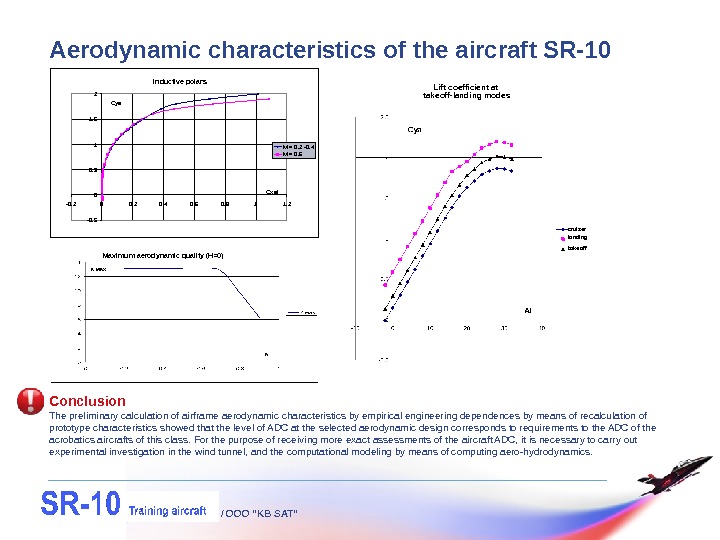
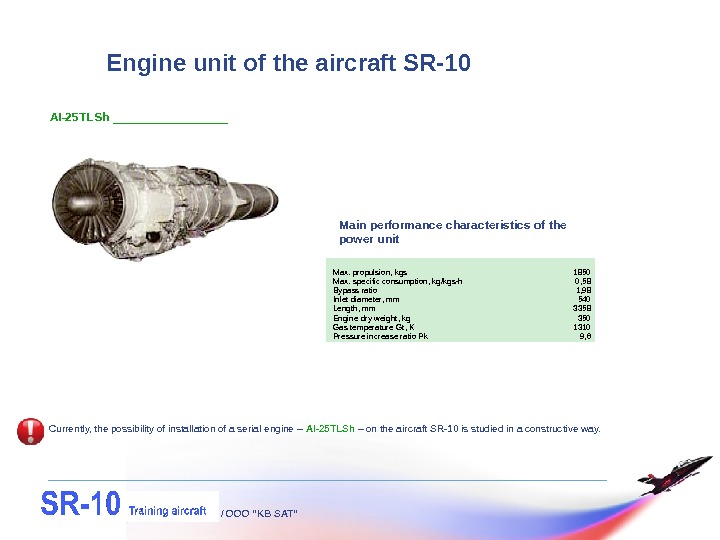
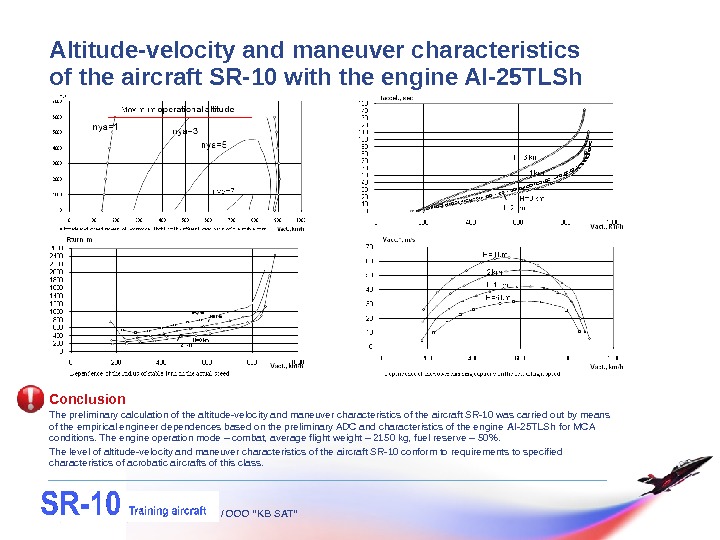
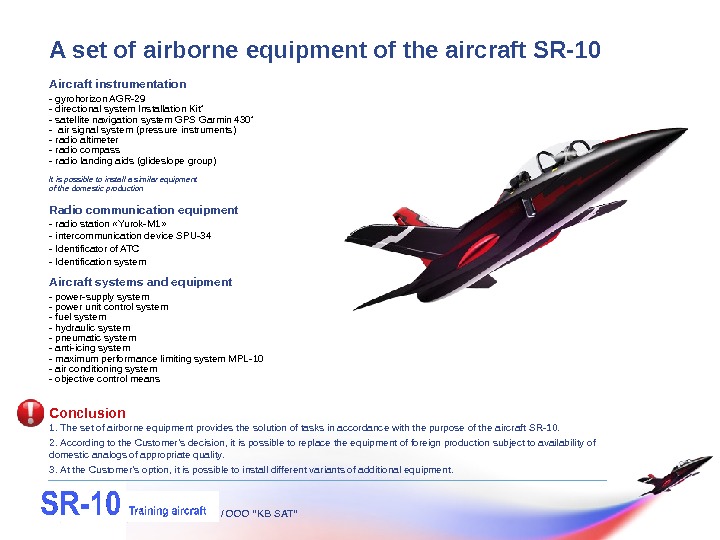
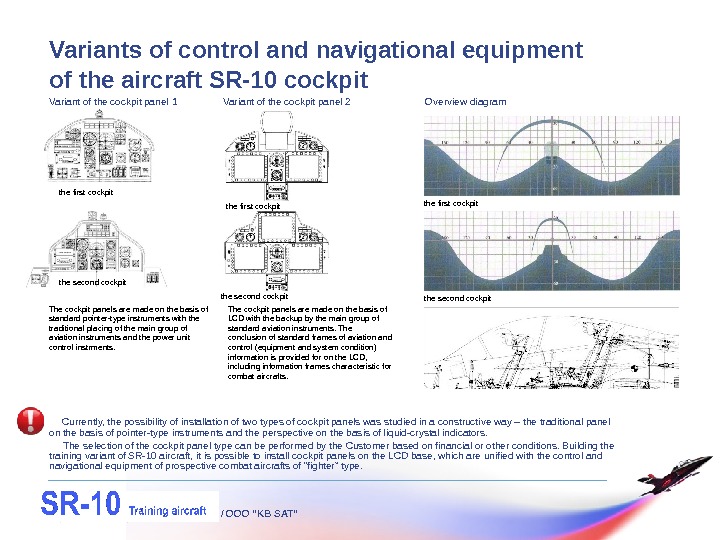
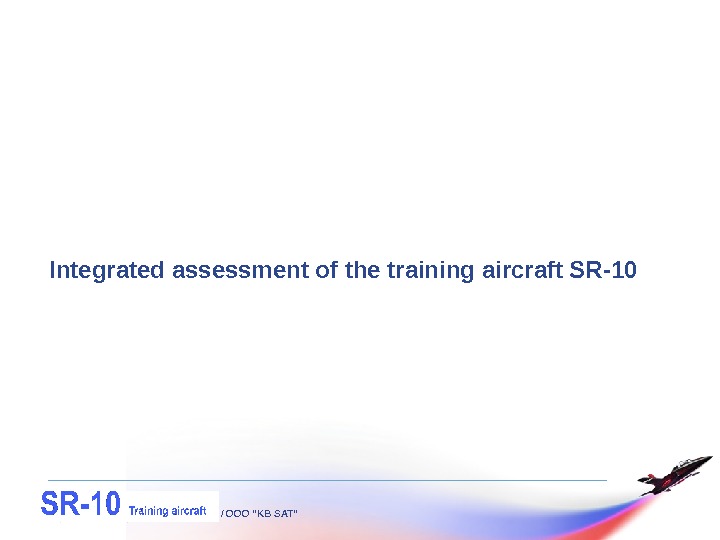
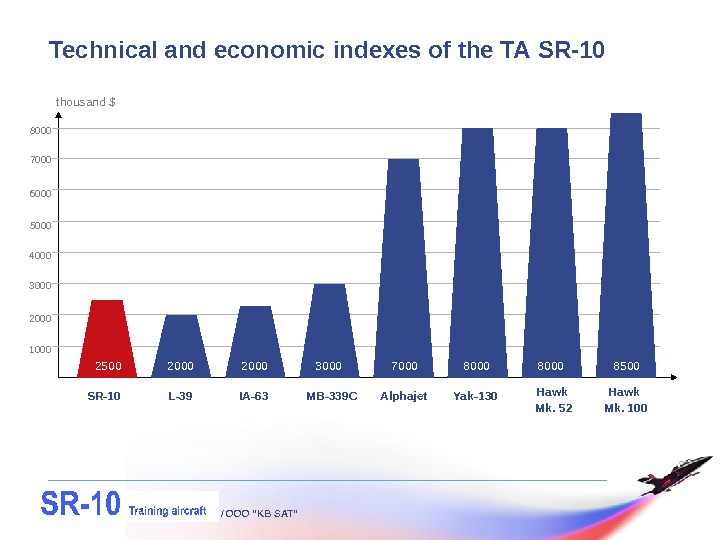
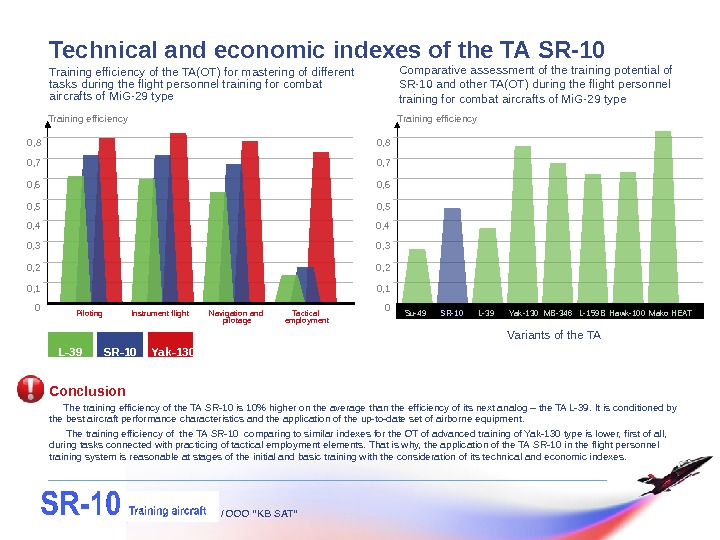
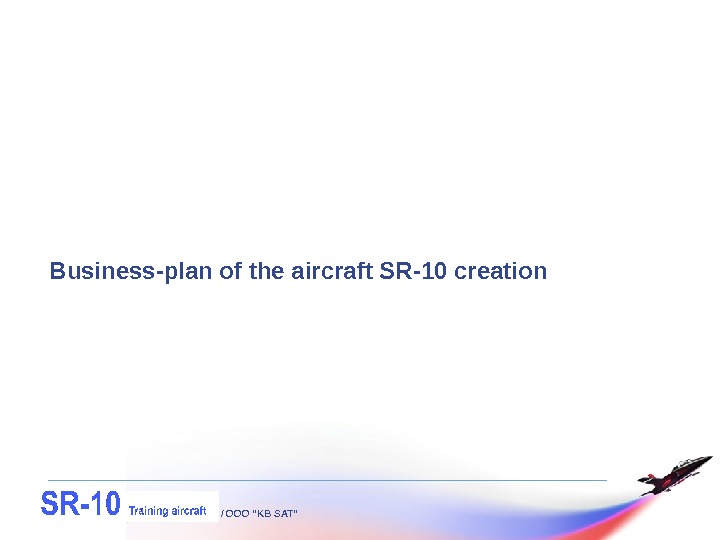
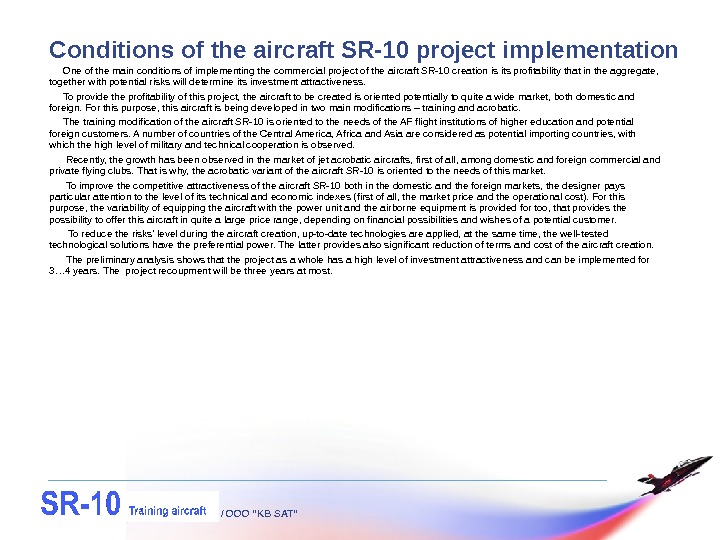
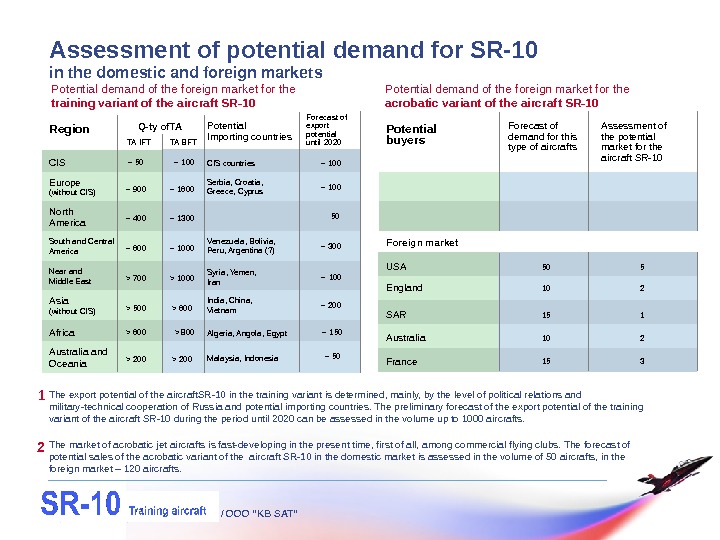
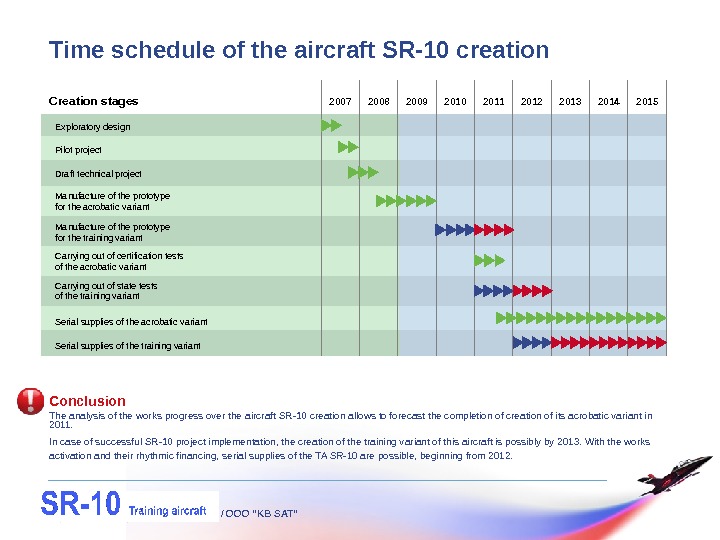
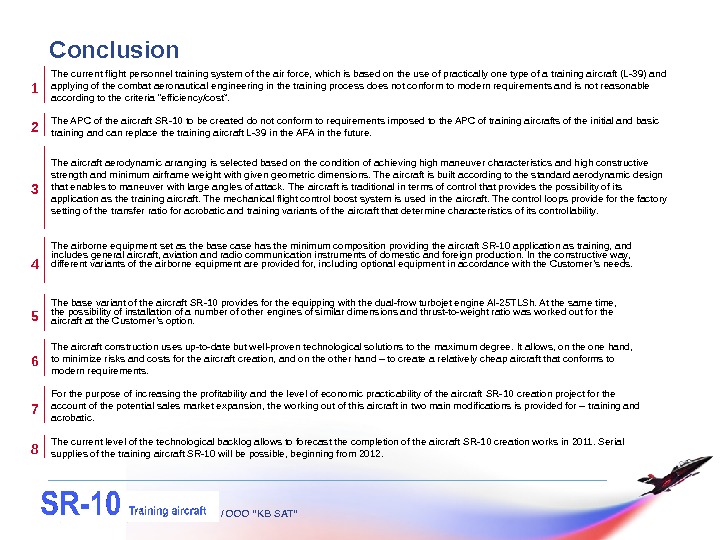
- Размер: 4.3 Mегабайта
- Количество слайдов: 27
Описание презентации Презентация presentation-cp10-eng по слайдам
 Engineer Note Moscow, 2009 APPROVE General Director of OOO “KB SAT” V. B. Shusterov «___» ______ 2009 CONCURRED BY Design manager of OOO “KB SAT” A. M. Manzheliy «___» ______ 2009 SR-10 Training aircraft
Engineer Note Moscow, 2009 APPROVE General Director of OOO “KB SAT” V. B. Shusterov «___» ______ 2009 CONCURRED BY Design manager of OOO “KB SAT” A. M. Manzheliy «___» ______ 2009 SR-10 Training aircraft
 Entering the service of the AF of up-to-date aircraft systems (AS) with new operational capabilities imposes increased demands towards the training level of the graduates of flight institutions of higher education. A modern pilot should possess the whole wealth of knowledge, skills and abilities allowing him to use the combat potential of up-to-date and perspective AS in all their application conditions to the full extent. The existing flight personnel training system based on the use of practically one type of the training aircraft (L-39) and the use of the combat aeronautical engineering (Mi. G-29, Su-25) in the training process is physically and morally outdated and does not comply with up-to-date requirements. Moreover, this training system is not reasonable according to the criterion “efficiency/cost”. The improvement of the flight personnel training system should be intended, first of all, for the formation of the rational training aircraft fleet that provides for the implementation of the reasonable stage-by-stage approach to the training and the use of training aircrafts (TA) adapted for the tasks of a corresponding training stage at every stage. The criteria of TA reasonable fleet formation for flight institutions of higher education should be the provision of a given number of flight personnel training with the required training quality with minimum training costs. Introduction / OOO “KB SAT” As a rule, the TA reasonable fleet includes three types of aircrafts providing the carrying out of the preliminary, basic and higher training. The optimization of the TA fleet characteristics based on principles of methodical unification and succession, the stage-by-stage increasing of methodical possibilities (“from simple to complex”) and complementarities with the consideration of up-to-date requirements to military pilots’ training will make it possible to create conditions for the further harmonic mastering of a combat aircraft. This approach will provide the achievement of a high quality of pilots’ training and minimizing of their training costs. The most important component that ensures the efficiency improvement of the pilots training process is the education integration providing for the methodic and information integration of training in auditoriums, on training simulators and during the flight. An integrated training complex (ITC) combining the TA, simulators and classrooms should be created for every training stage, which are built on the basis of interactive automated training systems. At the same time, all ITC shall form the uniform through system of combat pilots’ training on the methodical basis. One of the implementation conditions of perspective ITC creation projects in new economic conditions is their profitability, which is provided, first of all, by the volume of the serial production of corresponding TA. Increasing of TA serial production volumes can be achieved, on the one hand, for account of the sales markets expansion, first of all, foreign ones, which is provided by the consideration of their requirements, on the other hand – by the modification of a corresponding TA of another purpose, first of all, acrobatic ones. The latter is of immediate interest for the TA of the primary and basic training. That is why, the project of SR-10 aircraft creation provides for its development in two main modifications – training and acrobatic.
Entering the service of the AF of up-to-date aircraft systems (AS) with new operational capabilities imposes increased demands towards the training level of the graduates of flight institutions of higher education. A modern pilot should possess the whole wealth of knowledge, skills and abilities allowing him to use the combat potential of up-to-date and perspective AS in all their application conditions to the full extent. The existing flight personnel training system based on the use of practically one type of the training aircraft (L-39) and the use of the combat aeronautical engineering (Mi. G-29, Su-25) in the training process is physically and morally outdated and does not comply with up-to-date requirements. Moreover, this training system is not reasonable according to the criterion “efficiency/cost”. The improvement of the flight personnel training system should be intended, first of all, for the formation of the rational training aircraft fleet that provides for the implementation of the reasonable stage-by-stage approach to the training and the use of training aircrafts (TA) adapted for the tasks of a corresponding training stage at every stage. The criteria of TA reasonable fleet formation for flight institutions of higher education should be the provision of a given number of flight personnel training with the required training quality with minimum training costs. Introduction / OOO “KB SAT” As a rule, the TA reasonable fleet includes three types of aircrafts providing the carrying out of the preliminary, basic and higher training. The optimization of the TA fleet characteristics based on principles of methodical unification and succession, the stage-by-stage increasing of methodical possibilities (“from simple to complex”) and complementarities with the consideration of up-to-date requirements to military pilots’ training will make it possible to create conditions for the further harmonic mastering of a combat aircraft. This approach will provide the achievement of a high quality of pilots’ training and minimizing of their training costs. The most important component that ensures the efficiency improvement of the pilots training process is the education integration providing for the methodic and information integration of training in auditoriums, on training simulators and during the flight. An integrated training complex (ITC) combining the TA, simulators and classrooms should be created for every training stage, which are built on the basis of interactive automated training systems. At the same time, all ITC shall form the uniform through system of combat pilots’ training on the methodical basis. One of the implementation conditions of perspective ITC creation projects in new economic conditions is their profitability, which is provided, first of all, by the volume of the serial production of corresponding TA. Increasing of TA serial production volumes can be achieved, on the one hand, for account of the sales markets expansion, first of all, foreign ones, which is provided by the consideration of their requirements, on the other hand – by the modification of a corresponding TA of another purpose, first of all, acrobatic ones. The latter is of immediate interest for the TA of the primary and basic training. That is why, the project of SR-10 aircraft creation provides for its development in two main modifications – training and acrobatic.
 Purpose of the aircraft SR-10 / OOO “KB SAT”Training variant Acrobatic variant training of the pilot technique and standard, advanced and higher operation in accordance with tasks of the initial and basic flight training; training of navigation fundamentals and flight operation en-route using the standard navigation equipment; instrument flight rules operation ; group formation flight training in couples. training of the pilot technique and standard, advanced and higher operation separately and in complex in full range of the aircraft APC ; practicing of reverse aerobatics ; mastering of sports aerobatics ; participation in aircraft sports competitions.
Purpose of the aircraft SR-10 / OOO “KB SAT”Training variant Acrobatic variant training of the pilot technique and standard, advanced and higher operation in accordance with tasks of the initial and basic flight training; training of navigation fundamentals and flight operation en-route using the standard navigation equipment; instrument flight rules operation ; group formation flight training in couples. training of the pilot technique and standard, advanced and higher operation separately and in complex in full range of the aircraft APC ; practicing of reverse aerobatics ; mastering of sports aerobatics ; participation in aircraft sports competitions.
 Flight personnel training concept of the air force of the MF / OOO “KB SAT”
Flight personnel training concept of the air force of the MF / OOO “KB SAT”
 / OOO “KB SAT” The flight training concept means the system of fundamental views to interrelated programs of the flight training, the type of training complexes, their composition and technical characteristics that provide for the effective training of fighting capacity of military pilots. The concept of perspective system of flight training of pilots and navigators of the AF includes the stages of the initial, basic and advanced flight training in flight institutions of higher education, and the training of the combat-ready flight personnel in combat maneuver units and training centers in accordance with the Training program. Basic provisions Initial flight training It is a set of actions directed to the determination of the professional competence of a future student in the flight work and the formation of his initial skills of the piloting technique , the spatial and visual orientation. Basic flight training It is a set and practical mastering of the training aircraft and a student’s training of the piloting technique and navigation in the daytime and at night for the purpose of training a future military pilot. Advanced flight training It is a set of actions intended for the young pilot’s combat training fundamentals on a combat training jet aircraft in the daytime and at night in simple and intricate meteorological conditions for the purpose of training a combat-ready pilot. Each stage of the flight training has clear goals and objectives, which are followed at training complexes according to the stage. Every ITC should consist of a corresponding TA and ground training facilities. The TA of the initial training should be meant for the professional selection of future pilots and their teaching of fundamentals of piloting and navigation technique. The TA of the basic training should provide the formation of solid piloting and navigation skills in the daytime at VFR and IFR, at night at VFR in the altitude and speed range characteristic for combat aircrafts in accordance with the specialization of a future military pilot. It should be an aircraft with TJE or TPE, with the aircraft control and navigation equipment (CNE), similar to the CNE of the advanced training TA. At the same time, such TA should be significantly cheaper than the advanced training TA of a corresponding profile. The advanced training TA should provide the formation of solid piloting and navigation skills in the daytime and at night at VFR and IFR, and the combat training fundamentals in accordance with the specialization of a future military pilot. It should be an aircraft with TJE, APC and CNE similar to a corresponding combat aircraft.
/ OOO “KB SAT” The flight training concept means the system of fundamental views to interrelated programs of the flight training, the type of training complexes, their composition and technical characteristics that provide for the effective training of fighting capacity of military pilots. The concept of perspective system of flight training of pilots and navigators of the AF includes the stages of the initial, basic and advanced flight training in flight institutions of higher education, and the training of the combat-ready flight personnel in combat maneuver units and training centers in accordance with the Training program. Basic provisions Initial flight training It is a set of actions directed to the determination of the professional competence of a future student in the flight work and the formation of his initial skills of the piloting technique , the spatial and visual orientation. Basic flight training It is a set and practical mastering of the training aircraft and a student’s training of the piloting technique and navigation in the daytime and at night for the purpose of training a future military pilot. Advanced flight training It is a set of actions intended for the young pilot’s combat training fundamentals on a combat training jet aircraft in the daytime and at night in simple and intricate meteorological conditions for the purpose of training a combat-ready pilot. Each stage of the flight training has clear goals and objectives, which are followed at training complexes according to the stage. Every ITC should consist of a corresponding TA and ground training facilities. The TA of the initial training should be meant for the professional selection of future pilots and their teaching of fundamentals of piloting and navigation technique. The TA of the basic training should provide the formation of solid piloting and navigation skills in the daytime at VFR and IFR, at night at VFR in the altitude and speed range characteristic for combat aircrafts in accordance with the specialization of a future military pilot. It should be an aircraft with TJE or TPE, with the aircraft control and navigation equipment (CNE), similar to the CNE of the advanced training TA. At the same time, such TA should be significantly cheaper than the advanced training TA of a corresponding profile. The advanced training TA should provide the formation of solid piloting and navigation skills in the daytime and at night at VFR and IFR, and the combat training fundamentals in accordance with the specialization of a future military pilot. It should be an aircraft with TJE, APC and CNE similar to a corresponding combat aircraft.
 USA Great Britain Korea Brazil Turkey Japan / OOO “KB SAT”Analysis of TA and OT fleet used in flight training systems of the AF and main foreign countries Conclusion — The flight personnel training system of the AF in foreign countries provides for three stages of flight training – initial, basic, and advanced. — The flight training is performed at TA (OT) adapted to tasks of a given stage of the flight training at every stage. — The feature of the flight personnel training system is the use of a uniform TA at the stage of the initial and basic flight training and combat (operational) aircrafts at the advanced training stage. Initial flight training Basic flight training Advanced flight training T-6 B «Texan-II» Т-67 М КТ-1 Т-23; Т-25 Т-41, SF-260 F-2 B Т-6 A «Texan-II» Tucano T. 1 T-37 T-27, EMB. 325 T-37 T-7 Т-38 «Talon» Hawk-T. 1 (T. 1 A) Т-50 АТ-29 Т-38 Т-
USA Great Britain Korea Brazil Turkey Japan / OOO “KB SAT”Analysis of TA and OT fleet used in flight training systems of the AF and main foreign countries Conclusion — The flight personnel training system of the AF in foreign countries provides for three stages of flight training – initial, basic, and advanced. — The flight training is performed at TA (OT) adapted to tasks of a given stage of the flight training at every stage. — The feature of the flight personnel training system is the use of a uniform TA at the stage of the initial and basic flight training and combat (operational) aircrafts at the advanced training stage. Initial flight training Basic flight training Advanced flight training T-6 B «Texan-II» Т-67 М КТ-1 Т-23; Т-25 Т-41, SF-260 F-2 B Т-6 A «Texan-II» Tucano T. 1 T-37 T-27, EMB. 325 T-37 T-7 Т-38 «Talon» Hawk-T. 1 (T. 1 A) Т-50 АТ-29 Т-38 Т-
 / OOO “KB SAT”Key features of TA ( OT ), used in training systems of the AF in foreign countries Conclusion The world experience analysis shows that the following aircrafts are used for: TA IFT aircrafts with a reciprocating engine and weight up to 1500 kg are used, as a rule , TA BFT – aircrafts with TPE or TJE weight up to 5000 kg , TA AFT – aircrafts with TJE weight approx. 9000 kg. TA IFT TA BFT TA AFT Characteristics T-6 B Т-41 В ТВ. 30 Т-6 А Т-37 Hawk -T. 1 M-311 T-7 T-38 A Hawk -100 HJT-36 Operational range, km — 1630 1300 1574 1500 1040 — 850 2125 2520 775 Limit load factor, unit +6/-2, 4 +7/-3, 5 +7/-2, 5 Max. speed, km/h 585 250 380 574 580 1000 540 298 1380 1000 750 Operating ceiling, kg — 5200 7000 10670 11800 14600 9150 — 16300 13600 9000 Takeoff weight, kg 2550 1120 1250 2857 2980 7760 3150 1585 5485 9100 4500 Crew position tandem. Wing area , m 2 — 22, 02 9 — 17, 1 16, 69 12, 6 16, 5 15, 8 16, 7 -Wingspan, m 10, 1 11, 85 7, 92 10, 18 8, 2 9, 39 8, 43 10, 4 7, 7 9, 08 10, 0 Country USA Great Britain. USAFrance Italy Japan USA Australia India Engine unit , type/q-ty x power , hp TPE 1 х … RE 1 х 210 RE 1 х 300 TPE 1 х 1100 TJE 2 х 460 TFE 2 х 1216 TPE 1 х 1447 TPE 1 х 450 TFE 1 х … TFE 1 х 1410 TFE 1 х 2420 Aircraft length, m 10, 3 11, 51 7, 59 10, 16 8, 93 11, 85 8, 43 8, 59 14, 4 11, 4 10, 9 tandem tandem tandem
/ OOO “KB SAT”Key features of TA ( OT ), used in training systems of the AF in foreign countries Conclusion The world experience analysis shows that the following aircrafts are used for: TA IFT aircrafts with a reciprocating engine and weight up to 1500 kg are used, as a rule , TA BFT – aircrafts with TPE or TJE weight up to 5000 kg , TA AFT – aircrafts with TJE weight approx. 9000 kg. TA IFT TA BFT TA AFT Characteristics T-6 B Т-41 В ТВ. 30 Т-6 А Т-37 Hawk -T. 1 M-311 T-7 T-38 A Hawk -100 HJT-36 Operational range, km — 1630 1300 1574 1500 1040 — 850 2125 2520 775 Limit load factor, unit +6/-2, 4 +7/-3, 5 +7/-2, 5 Max. speed, km/h 585 250 380 574 580 1000 540 298 1380 1000 750 Operating ceiling, kg — 5200 7000 10670 11800 14600 9150 — 16300 13600 9000 Takeoff weight, kg 2550 1120 1250 2857 2980 7760 3150 1585 5485 9100 4500 Crew position tandem. Wing area , m 2 — 22, 02 9 — 17, 1 16, 69 12, 6 16, 5 15, 8 16, 7 -Wingspan, m 10, 1 11, 85 7, 92 10, 18 8, 2 9, 39 8, 43 10, 4 7, 7 9, 08 10, 0 Country USA Great Britain. USAFrance Italy Japan USA Australia India Engine unit , type/q-ty x power , hp TPE 1 х … RE 1 х 210 RE 1 х 300 TPE 1 х 1100 TJE 2 х 460 TFE 2 х 1216 TPE 1 х 1447 TPE 1 х 450 TFE 1 х … TFE 1 х 1410 TFE 1 х 2420 Aircraft length, m 10, 3 11, 51 7, 59 10, 16 8, 93 11, 85 8, 43 8, 59 14, 4 11, 4 10, 9 tandem tandem tandem
 / OOO “KB SAT”Analysis of requirements to the APC of training and combat aircrafts for different flight personnel training stages Conclusion According to its APC, the TA SR-10 complies with requirements imposed to the APC of the TA BFT best of all and can further replace L-39 at AFA (MI) used for the initial and basic flight training. Key APC Requirements of the AF to the TA Su-49 TA IFT TA BFT TA AFT Yak-152 L-39 Yak-130 TA SR-10 Operational range, km Limit load factor, unit. Max. speed, km/h Operating ceiling, km. Takeoff weight , kg norm/max. Crew position. Engine unit , type/q-ty x power , hp Landing speed, km/h 800 RE 1 х … TFE 1 х 1900 TFE 2 х … RE 1 х 420 RE 1 х 360 TFE 1 х 1900 TFE 2 х 2500 TFE 1 х 1850 tandem tandem <1300 1500 3000 1310 280 >850 315 375 700 1000 845 >4, 0 до 12, 0 >10, 0 6, 3 3, 6 11, 4 12, 3 6, 0 >750 1200 >2000 1550 1000 980 2100 1200 +8/-4 +7/-3 +8/-3 +11/-7 +8/-6 +8/-4 +8/-3 +9/-6 100 -120 160 180 -250 115 120 185 —
/ OOO “KB SAT”Analysis of requirements to the APC of training and combat aircrafts for different flight personnel training stages Conclusion According to its APC, the TA SR-10 complies with requirements imposed to the APC of the TA BFT best of all and can further replace L-39 at AFA (MI) used for the initial and basic flight training. Key APC Requirements of the AF to the TA Su-49 TA IFT TA BFT TA AFT Yak-152 L-39 Yak-130 TA SR-10 Operational range, km Limit load factor, unit. Max. speed, km/h Operating ceiling, km. Takeoff weight , kg norm/max. Crew position. Engine unit , type/q-ty x power , hp Landing speed, km/h 800 RE 1 х … TFE 1 х 1900 TFE 2 х … RE 1 х 420 RE 1 х 360 TFE 1 х 1900 TFE 2 х 2500 TFE 1 х 1850 tandem tandem <1300 1500 3000 1310 280 >850 315 375 700 1000 845 >4, 0 до 12, 0 >10, 0 6, 3 3, 6 11, 4 12, 3 6, 0 >750 1200 >2000 1550 1000 980 2100 1200 +8/-4 +7/-3 +8/-3 +11/-7 +8/-6 +8/-4 +8/-3 +9/-6 100 -120 160 180 -250 115 120 185 —
 / OOO “KB SAT”Role and place of the aircraft SR-10 in the flight personnel training system Conclusion The analysis of conditions of tasks and exercises fulfillment of the flight training stages shows that according to its APC, the TA SR-100 provides the solution of tasks of the initial and basic flight training. 0 200 400 600 800 10002468101214 AFT BFT IFTFlight altitude, km Flight speed, km/h. SR-10 L-39 Yak —
/ OOO “KB SAT”Role and place of the aircraft SR-10 in the flight personnel training system Conclusion The analysis of conditions of tasks and exercises fulfillment of the flight training stages shows that according to its APC, the TA SR-100 provides the solution of tasks of the initial and basic flight training. 0 200 400 600 800 10002468101214 AFT BFT IFTFlight altitude, km Flight speed, km/h. SR-10 L-39 Yak —
 / OOO “KB SAT”Technical characteristics of the aircraft SR-
/ OOO “KB SAT”Technical characteristics of the aircraft SR-
 / OOO “KB SAT” The aircraft SR-10 has been developed by OOO “KB “Modern Aviation Technologies” in accordance with the initiative procedure as an acrobatic jet aircraft with the dimension up to 2700 kg. This aircraft can be produced as the training variant designed for the basic flight training of students – future military pilots – for the operation of up-to-date combat jets. Up-to-date, commercial technological solutions are used in the aircraft construction to the maximum degree. It allows, on the one hand, to minimize risks and costs for the aircraft creation, on the other hand – to create a relatively cheap aircraft complying with modern requirements. The aerodynamic composition of the aircraft was selected based on the condition of achieving high maneuvering characteristics and high structural strength, and minimum airframe weight with given geometric dimensions. The aircraft is built according to a standard aerodynamic scheme enabling maneuvering at wide angle of attack. The aircraft uses the mechanical power-boosted control system. The control loop provides for the factory setting of gear ratio for acrobatics and training aircraft variants, which determine their control characteristics. To provide the flight safety, the control loop can be added with the maximum mode limiting system MML-10 (first of all, for the training variant). General information The airframe is made with a high degree of integrity, when the wing and the hull form the uniform all-body that provide high values of aerodynamic quality. The tricycle-equipped landing gear with a nose-wheel. The head of the hull includes: the nose section with the equipment, the front gear bay, the pressurized double cockpit with a lamp. The middle part of the hull includes: the equipment compartment behind the cockpit, the hull fuel tank, side air intakes. The wing spars are attached to the power frames, side beams with attachment points of main gears are located along the sides. The aft part of the fuselage includes: the engine compartment, the life support and air conditioning systems. The vertical and horizontal empennages are attached to the aft part of side beams. The set of the base case airborne equipment is minimum that provides the aircraft operation according to its purpose and includes the general aircraft, instrumentation and radio communication equipment of domestic and foreign production. The selection of the foreign-made equipment is dictated mainly by the absence of domestic analogs of the required quality and based on weight/dimension indicators. Variants of the airborne equipment kitting, including additional one will be determined upon coordination with Customers.
/ OOO “KB SAT” The aircraft SR-10 has been developed by OOO “KB “Modern Aviation Technologies” in accordance with the initiative procedure as an acrobatic jet aircraft with the dimension up to 2700 kg. This aircraft can be produced as the training variant designed for the basic flight training of students – future military pilots – for the operation of up-to-date combat jets. Up-to-date, commercial technological solutions are used in the aircraft construction to the maximum degree. It allows, on the one hand, to minimize risks and costs for the aircraft creation, on the other hand – to create a relatively cheap aircraft complying with modern requirements. The aerodynamic composition of the aircraft was selected based on the condition of achieving high maneuvering characteristics and high structural strength, and minimum airframe weight with given geometric dimensions. The aircraft is built according to a standard aerodynamic scheme enabling maneuvering at wide angle of attack. The aircraft uses the mechanical power-boosted control system. The control loop provides for the factory setting of gear ratio for acrobatics and training aircraft variants, which determine their control characteristics. To provide the flight safety, the control loop can be added with the maximum mode limiting system MML-10 (first of all, for the training variant). General information The airframe is made with a high degree of integrity, when the wing and the hull form the uniform all-body that provide high values of aerodynamic quality. The tricycle-equipped landing gear with a nose-wheel. The head of the hull includes: the nose section with the equipment, the front gear bay, the pressurized double cockpit with a lamp. The middle part of the hull includes: the equipment compartment behind the cockpit, the hull fuel tank, side air intakes. The wing spars are attached to the power frames, side beams with attachment points of main gears are located along the sides. The aft part of the fuselage includes: the engine compartment, the life support and air conditioning systems. The vertical and horizontal empennages are attached to the aft part of side beams. The set of the base case airborne equipment is minimum that provides the aircraft operation according to its purpose and includes the general aircraft, instrumentation and radio communication equipment of domestic and foreign production. The selection of the foreign-made equipment is dictated mainly by the absence of domestic analogs of the required quality and based on weight/dimension indicators. Variants of the airborne equipment kitting, including additional one will be determined upon coordination with Customers.
 / OOO “KB SAT” The base variant of the aircraft SR-10 provides for the equipping with the dual-flow turbojet engine AI-25 TLSh. The aircraft is equipped with catapult chairs K-93. Together with the protective equipment the chairs provide safe escaping of the crew from the aircraft at speeds up to 950 km/h within the limits of operational range of altitudes, including modes V=0, H=0. Automatic devices of the chairs provide safe escaping of the crew from the aircraft for both one and two people. Generally, the technical characteristics of the aircraft and its aircraft performance characteristics conform to the world level. Arrangement of the aircraft SR-
/ OOO “KB SAT” The base variant of the aircraft SR-10 provides for the equipping with the dual-flow turbojet engine AI-25 TLSh. The aircraft is equipped with catapult chairs K-93. Together with the protective equipment the chairs provide safe escaping of the crew from the aircraft at speeds up to 950 km/h within the limits of operational range of altitudes, including modes V=0, H=0. Automatic devices of the chairs provide safe escaping of the crew from the aircraft for both one and two people. Generally, the technical characteristics of the aircraft and its aircraft performance characteristics conform to the world level. Arrangement of the aircraft SR-
 / OOO “KB SAT”Main aircraft performance characteristics of the aircraft SR-10 Main aircraft performance characteristics Crew Maximum flight speed Maximum horizontal flight speed Maximum M value Liftoff speed Landing speed Cruising speed at Н=6000 m Maximum climbing capacity at the ground Minimum radius of the stable turn Maximum roll angle rotational speed Maximum distance Practical ceiling Weight characteristics Standard takeoff weight Maximum takeoff weight Standard landing weight Maximum landing weight 2 persons 700 km/h 900 km/h 0. 85 190 km/h 185 km/h 520 km/h 60 m/s 290 m 7 rad / s 1500 km 6000 m 2400 kg 2700 kg 2000 kg 2700 kg
/ OOO “KB SAT”Main aircraft performance characteristics of the aircraft SR-10 Main aircraft performance characteristics Crew Maximum flight speed Maximum horizontal flight speed Maximum M value Liftoff speed Landing speed Cruising speed at Н=6000 m Maximum climbing capacity at the ground Minimum radius of the stable turn Maximum roll angle rotational speed Maximum distance Practical ceiling Weight characteristics Standard takeoff weight Maximum takeoff weight Standard landing weight Maximum landing weight 2 persons 700 km/h 900 km/h 0. 85 190 km/h 185 km/h 520 km/h 60 m/s 290 m 7 rad / s 1500 km 6000 m 2400 kg 2700 kg 2000 kg 2700 kg
 / OOO “KB SAT”Substantiation of the airframe construction and aerodynamic design of the aircraft SR-10 Variants of aerodynamic arrangement Factors that stipulated the selection of the aerodynamic arrangement of the aircraft SR-10 — High maneuver characteristics — High speed characteristics — Low takeoff and landing speed — Minimum airframe weight at given geometric dimensions — Providing of high structural strength at high values of standard overload ( up to +11 g ) Features of the selected aerodynamic design of the aircraft SR-10 airframe he Tkey feature of the aerodynamic design – a high-wing aircraft with the wing of moderate sweepforward and advanced root swelling. Aerodynamic wing profile with the relative thickness The airframe is made according to a standard aerodynamic design. The hull of traditional form with side air intakes. Control elements : — slot flap with the variation 15 º ( takeoff mode ) and 40 º ( landing mode ); — longitudinal channel – all-moving horizontal empennage ( variation angles – -20 º … +15 º ); — lateral channel – ailerons ( variation angles – ± 25 º ); — track channel – rudder ( variation angles – ± 27 º ).
/ OOO “KB SAT”Substantiation of the airframe construction and aerodynamic design of the aircraft SR-10 Variants of aerodynamic arrangement Factors that stipulated the selection of the aerodynamic arrangement of the aircraft SR-10 — High maneuver characteristics — High speed characteristics — Low takeoff and landing speed — Minimum airframe weight at given geometric dimensions — Providing of high structural strength at high values of standard overload ( up to +11 g ) Features of the selected aerodynamic design of the aircraft SR-10 airframe he Tkey feature of the aerodynamic design – a high-wing aircraft with the wing of moderate sweepforward and advanced root swelling. Aerodynamic wing profile with the relative thickness The airframe is made according to a standard aerodynamic design. The hull of traditional form with side air intakes. Control elements : — slot flap with the variation 15 º ( takeoff mode ) and 40 º ( landing mode ); — longitudinal channel – all-moving horizontal empennage ( variation angles – -20 º … +15 º ); — lateral channel – ailerons ( variation angles – ± 25 º ); — track channel – rudder ( variation angles – ± 27 º ).
 / OOO “KB SAT”Aerodynamic characteristics of the aircraft SR-10 Conclusion The preliminary calculation of airframe aerodynamic characteristics by empirical engineering dependences by means of recalculation of prototype characteristics showed that the level of ADC at the selected aerodynamic design corresponds to requirements to the ADC of the acrobatics aircrafts of this class. For the purpose of receiving more exact assessments of the aircraft ADC, it is necessary to carry out experimental investigation in the wind tunnel, and the computational modeling by means of computing aero-hydrodynamics. Индуктивные поляры -0. 5 0 0. 5 1 1. 5 2 -0. 20. 40. 60. 811. 2 Cxai Cya M = 0. 2 -0. 4 M = 0. 6 Inductive polars Maximum aerodynamic quality (H=0) Lift coefficient at takeoff-landing modes cruiser landing takeoff
/ OOO “KB SAT”Aerodynamic characteristics of the aircraft SR-10 Conclusion The preliminary calculation of airframe aerodynamic characteristics by empirical engineering dependences by means of recalculation of prototype characteristics showed that the level of ADC at the selected aerodynamic design corresponds to requirements to the ADC of the acrobatics aircrafts of this class. For the purpose of receiving more exact assessments of the aircraft ADC, it is necessary to carry out experimental investigation in the wind tunnel, and the computational modeling by means of computing aero-hydrodynamics. Индуктивные поляры -0. 5 0 0. 5 1 1. 5 2 -0. 20. 40. 60. 811. 2 Cxai Cya M = 0. 2 -0. 4 M = 0. 6 Inductive polars Maximum aerodynamic quality (H=0) Lift coefficient at takeoff-landing modes cruiser landing takeoff
 / OOO “KB SAT”Engine unit of the aircraft SR-10 Currently, the possibility of installation of a serial engine – AI -25 TLSh – on the aircraft SR-10 is studied in a constructive way. AI -25 TLSh Main performance characteristics of the power unit Max. propulsion, kgs Max. specific consumption, kg/kgs-h Bypass ratio Inlet diameter, mm Length, mm Engine dry weight, kg Gas temperature Gt , K Pressure increase ratio Pk 1850 0, 58 1, 98 540 3358 350 1310 9,
/ OOO “KB SAT”Engine unit of the aircraft SR-10 Currently, the possibility of installation of a serial engine – AI -25 TLSh – on the aircraft SR-10 is studied in a constructive way. AI -25 TLSh Main performance characteristics of the power unit Max. propulsion, kgs Max. specific consumption, kg/kgs-h Bypass ratio Inlet diameter, mm Length, mm Engine dry weight, kg Gas temperature Gt , K Pressure increase ratio Pk 1850 0, 58 1, 98 540 3358 350 1310 9,
 / OOO “KB SAT”Altitude-velocity and maneuver characteristics of the aircraft SR-10 with the engine AI-25 TLSh Conclusion The preliminary calculation of the altitude-velocity and maneuver characteristics of the aircraft SR-10 was carried out by means of the empirical engineer dependences based on the preliminary ADC and characteristics of the engine AI-25 TLSh for MCA conditions. The engine operation mode – combat, average flight weight – 2150 kg, fuel reserve – 50%. The level of altitude-velocity and maneuver characteristics of the aircraft SR-10 conform to requirements to specified characteristics of acrobatic aircrafts of this class.
/ OOO “KB SAT”Altitude-velocity and maneuver characteristics of the aircraft SR-10 with the engine AI-25 TLSh Conclusion The preliminary calculation of the altitude-velocity and maneuver characteristics of the aircraft SR-10 was carried out by means of the empirical engineer dependences based on the preliminary ADC and characteristics of the engine AI-25 TLSh for MCA conditions. The engine operation mode – combat, average flight weight – 2150 kg, fuel reserve – 50%. The level of altitude-velocity and maneuver characteristics of the aircraft SR-10 conform to requirements to specified characteristics of acrobatic aircrafts of this class.
 / OOO “KB SAT”A set of airborne equipment of the aircraft SR-10 Conclusion 1. The set of airborne equipment provides the solution of tasks in accordance with the purpose of the aircraft SR-10. 2. According to the Customer’s decision, it is possible to replace the equipment of foreign production subject to availability of domestic analogs of appropriate quality. 3. At the Customer’s option, it is possible to install different variants of additional equipment. Aircraft instrumentation — gyrohorizon AGR -29 — directional system Installation Kit * — satellite navigation system GPS Garmin 430 * — air signal system ( pressure instruments ) — radio altimeter — radio compass — radio landing aids ( glideslope group ) It is possible to install a similar equipment of the domestic production Radio communication equipment — radio station « Yurok — M 1» — intercommunication device SPU -34 — Identificator of ATC — Identification system Aircraft systems and equipment — power-supply system — power unit control system — fuel system — hydraulic system — pneumatic system — anti-icing system — maximum performance limiting system MPL -10 — air conditioning system — objective control means
/ OOO “KB SAT”A set of airborne equipment of the aircraft SR-10 Conclusion 1. The set of airborne equipment provides the solution of tasks in accordance with the purpose of the aircraft SR-10. 2. According to the Customer’s decision, it is possible to replace the equipment of foreign production subject to availability of domestic analogs of appropriate quality. 3. At the Customer’s option, it is possible to install different variants of additional equipment. Aircraft instrumentation — gyrohorizon AGR -29 — directional system Installation Kit * — satellite navigation system GPS Garmin 430 * — air signal system ( pressure instruments ) — radio altimeter — radio compass — radio landing aids ( glideslope group ) It is possible to install a similar equipment of the domestic production Radio communication equipment — radio station « Yurok — M 1» — intercommunication device SPU -34 — Identificator of ATC — Identification system Aircraft systems and equipment — power-supply system — power unit control system — fuel system — hydraulic system — pneumatic system — anti-icing system — maximum performance limiting system MPL -10 — air conditioning system — objective control means
 / OOO “KB SAT”Variants of control and navigational equipment of the aircraft SR-10 cockpit Currently, the possibility of installation of two types of cockpit panels was studied in a constructive way – the traditional panel on the basis of pointer-type instruments and the perspective on the basis of liquid-crystal indicators. The selection of the cockpit panel type can be performed by the Customer based on financial or other conditions. Building the training variant of SR-10 aircraft, it is possible to install cockpit panels on the LCD base, which are unified with the control and navigational equipment of prospective combat aircrafts of “fighter” type. Variant of the cockpit panel 1 Variant of the cockpit panel 2 the second cockpit the first cockpit Overview diagram the second cockpitthe first cockpit The cockpit panels are made on the basis of standard pointer-type instruments with the traditional placing of the main group of aviation instruments and the power unit control instrments. The cockpit panels are made on the basis of LCD with the backup by the main group of standard aviation instruments. The conclusion of standard frames of aviation and control (equipment and system condition) information is provided for on the LCD, including information frames characteristic for combat aircrafts.
/ OOO “KB SAT”Variants of control and navigational equipment of the aircraft SR-10 cockpit Currently, the possibility of installation of two types of cockpit panels was studied in a constructive way – the traditional panel on the basis of pointer-type instruments and the perspective on the basis of liquid-crystal indicators. The selection of the cockpit panel type can be performed by the Customer based on financial or other conditions. Building the training variant of SR-10 aircraft, it is possible to install cockpit panels on the LCD base, which are unified with the control and navigational equipment of prospective combat aircrafts of “fighter” type. Variant of the cockpit panel 1 Variant of the cockpit panel 2 the second cockpit the first cockpit Overview diagram the second cockpitthe first cockpit The cockpit panels are made on the basis of standard pointer-type instruments with the traditional placing of the main group of aviation instruments and the power unit control instrments. The cockpit panels are made on the basis of LCD with the backup by the main group of standard aviation instruments. The conclusion of standard frames of aviation and control (equipment and system condition) information is provided for on the LCD, including information frames characteristic for combat aircrafts.
 / OOO “KB SAT”Integrated assessment of the training aircraft SR-
/ OOO “KB SAT”Integrated assessment of the training aircraft SR-
 / OOO “KB SAT”Technical and economic indexes of the TA SR-10 thousand $ 1000200030004000 500060007000 8000 L-3920002500 2000 3000 7000 8000 8500 SR-10 IA-63 MB-339 C Alphajet Yak-130 Hawk Mk. 52 Hawk Mk.
/ OOO “KB SAT”Technical and economic indexes of the TA SR-10 thousand $ 1000200030004000 500060007000 8000 L-3920002500 2000 3000 7000 8000 8500 SR-10 IA-63 MB-339 C Alphajet Yak-130 Hawk Mk. 52 Hawk Mk.
 0, 10, 20, 30, 4 0, 50, 6 0, 7 0, 8 0 Training efficiency / OOO “KB SAT”Technical and economic indexes of the TA SR-10 Training efficiency of the TA ( OT ) for mastering of different tasks during the flight personnel training for combat aircrafts of Mi. G-29 type Piloting Instrument flight Navigation and pilotage Tactical employment Conclusion The training efficiency of the TA SR-10 is 10% higher on the average than the efficiency of its next analog – the TA L-39. It is conditioned by the best aircraft performance characteristics and the application of the up-to-date set of airborne equipment. The training efficiency of the TA SR-10 comparing to similar indexes for the OT of advanced training of Yak-130 type is lower, first of all, during tasks connected with practicing of tactical employment elements. That is why, the application of the TA SR-10 in the flight personnel training system is reasonable at stages of the initial and basic training with the consideration of its technical and economic indexes. L-39 SR-10 Yak -130 Comparative assessment of the training potential of SR-10 and other TA ( OT ) during the flight personnel training for combat aircrafts of Mi. G-29 type Variants of the TASu-49 SR-10 L-39 Yak-130 МВ-346 L-159 B Hawk-100 Mako HEAT
0, 10, 20, 30, 4 0, 50, 6 0, 7 0, 8 0 Training efficiency / OOO “KB SAT”Technical and economic indexes of the TA SR-10 Training efficiency of the TA ( OT ) for mastering of different tasks during the flight personnel training for combat aircrafts of Mi. G-29 type Piloting Instrument flight Navigation and pilotage Tactical employment Conclusion The training efficiency of the TA SR-10 is 10% higher on the average than the efficiency of its next analog – the TA L-39. It is conditioned by the best aircraft performance characteristics and the application of the up-to-date set of airborne equipment. The training efficiency of the TA SR-10 comparing to similar indexes for the OT of advanced training of Yak-130 type is lower, first of all, during tasks connected with practicing of tactical employment elements. That is why, the application of the TA SR-10 in the flight personnel training system is reasonable at stages of the initial and basic training with the consideration of its technical and economic indexes. L-39 SR-10 Yak -130 Comparative assessment of the training potential of SR-10 and other TA ( OT ) during the flight personnel training for combat aircrafts of Mi. G-29 type Variants of the TASu-49 SR-10 L-39 Yak-130 МВ-346 L-159 B Hawk-100 Mako HEAT
 / OOO “KB SAT”Business-plan of the aircraft SR-10 creation
/ OOO “KB SAT”Business-plan of the aircraft SR-10 creation
 / OOO “KB SAT” One of the main conditions of implementing the commercial project of the aircraft SR-10 creation is its profitability that in the aggregate, together with potential risks will determine its investment attractiveness. To provide the profitability of this project, the aircraft to be created is oriented potentially to quite a wide market, both domestic and foreign. For this purpose, this aircraft is being developed in two main modifications – training and acrobatic. The training modification of the aircraft SR-10 is oriented to the needs of the AF flight institutions of higher education and potential foreign customers. A number of countries of the Central America, Africa and Asia are considered as potential importing countries, with which the high level of military and technical cooperation is observed. Recently, the growth has been observed in the market of jet acrobatic aircrafts, first of all, among domestic and foreign commercial and private flying clubs. That is why, the acrobatic variant of the aircraft SR-10 is oriented to the needs of this market. To improve the competitive attractiveness of the aircraft SR-10 both in the domestic and the foreign markets, the designer pays particular attention to the level of its technical and economic indexes (first of all, the market price and the operational cost). For this purpose, the variability of equipping the aircraft with the power unit and the airborne equipment is provided for too, that provides the possibility to offer this aircraft in quite a large price range, depending on financial possibilities and wishes of a potential customer. To reduce the risks’ level during the aircraft creation, up-to-date technologies are applied, at the same time, the well-tested technological solutions have the preferential power. The latter provides also significant reduction of terms and cost of the aircraft creation. The preliminary analysis shows that the project as a whole has a high level of investment attractiveness and can be implemented for 3… 4 years. The project recoupment will be three years at most. Conditions of the aircraft SR-10 project implementation
/ OOO “KB SAT” One of the main conditions of implementing the commercial project of the aircraft SR-10 creation is its profitability that in the aggregate, together with potential risks will determine its investment attractiveness. To provide the profitability of this project, the aircraft to be created is oriented potentially to quite a wide market, both domestic and foreign. For this purpose, this aircraft is being developed in two main modifications – training and acrobatic. The training modification of the aircraft SR-10 is oriented to the needs of the AF flight institutions of higher education and potential foreign customers. A number of countries of the Central America, Africa and Asia are considered as potential importing countries, with which the high level of military and technical cooperation is observed. Recently, the growth has been observed in the market of jet acrobatic aircrafts, first of all, among domestic and foreign commercial and private flying clubs. That is why, the acrobatic variant of the aircraft SR-10 is oriented to the needs of this market. To improve the competitive attractiveness of the aircraft SR-10 both in the domestic and the foreign markets, the designer pays particular attention to the level of its technical and economic indexes (first of all, the market price and the operational cost). For this purpose, the variability of equipping the aircraft with the power unit and the airborne equipment is provided for too, that provides the possibility to offer this aircraft in quite a large price range, depending on financial possibilities and wishes of a potential customer. To reduce the risks’ level during the aircraft creation, up-to-date technologies are applied, at the same time, the well-tested technological solutions have the preferential power. The latter provides also significant reduction of terms and cost of the aircraft creation. The preliminary analysis shows that the project as a whole has a high level of investment attractiveness and can be implemented for 3… 4 years. The project recoupment will be three years at most. Conditions of the aircraft SR-10 project implementation
 / OOO “KB SAT”Assessment of potential demand for SR-10 in the domestic and foreign markets The export potential of the aircraft SR-10 in the training variant is determined, mainly, by the level of political relations and military-technical cooperation of Russia and potential importing countries. The preliminary forecast of the export potential of the training variant of the aircraft SR-10 during the period until 2020 can be assessed in the volume up to 1000 aircrafts. The market of acrobatic jet aircrafts is fast-developing in the present time, first of all, among commercial flying clubs. The forecast of potential sales of the acrobatic variant of the aircraft SR-10 in the domestic market is assessed in the volume of 50 aircrafts, in the foreign market – 120 aircrafts. 1 2 Potential demand of the foreign market for the training variant of the aircraft SR-10 Potential demand of the foreign market for the acrobatic variant of the aircraft SR-10 Region Q-ty of. TA TA IFT TA BFT CIS ~ 50 ~ 100 Europe ( without CIS ) ~ 900 ~ 1600 Potential Importing countries Forecast of export potential until 2020 CIS countries ~ 100 Serbia, Croatia, Greece, Cyprus ~ 100 North America ~ 400 ~ 1300 50 South and Central America ~ 600 ~ 1000 Venezuela, Bolivia , Peru, Argentina (? ) ~ 300 Near and Middle East > 700 > 1000 Syria, Yemen , Iran ~ 100 Asia ( without CIS ) > 500 > 600 India, China, Vietnam ~ 200 Africa > 600 > 800 Algeria, Angola, Egypt ~ 150 Australia and Oceania > 200 Malaysia, Indonesia ~ 50 Foreign market. Potential buyers Forecast of demand for this type of aircrafts Assessment of the potential market for the aircraft SR-10 50 USA 10 England 15 SAR 10 Australia 15 France
/ OOO “KB SAT”Assessment of potential demand for SR-10 in the domestic and foreign markets The export potential of the aircraft SR-10 in the training variant is determined, mainly, by the level of political relations and military-technical cooperation of Russia and potential importing countries. The preliminary forecast of the export potential of the training variant of the aircraft SR-10 during the period until 2020 can be assessed in the volume up to 1000 aircrafts. The market of acrobatic jet aircrafts is fast-developing in the present time, first of all, among commercial flying clubs. The forecast of potential sales of the acrobatic variant of the aircraft SR-10 in the domestic market is assessed in the volume of 50 aircrafts, in the foreign market – 120 aircrafts. 1 2 Potential demand of the foreign market for the training variant of the aircraft SR-10 Potential demand of the foreign market for the acrobatic variant of the aircraft SR-10 Region Q-ty of. TA TA IFT TA BFT CIS ~ 50 ~ 100 Europe ( without CIS ) ~ 900 ~ 1600 Potential Importing countries Forecast of export potential until 2020 CIS countries ~ 100 Serbia, Croatia, Greece, Cyprus ~ 100 North America ~ 400 ~ 1300 50 South and Central America ~ 600 ~ 1000 Venezuela, Bolivia , Peru, Argentina (? ) ~ 300 Near and Middle East > 700 > 1000 Syria, Yemen , Iran ~ 100 Asia ( without CIS ) > 500 > 600 India, China, Vietnam ~ 200 Africa > 600 > 800 Algeria, Angola, Egypt ~ 150 Australia and Oceania > 200 Malaysia, Indonesia ~ 50 Foreign market. Potential buyers Forecast of demand for this type of aircrafts Assessment of the potential market for the aircraft SR-10 50 USA 10 England 15 SAR 10 Australia 15 France
 / OOO “KB SAT”Time schedule of the aircraft SR-10 creation Conclusion The analysis of the works progress over the aircraft SR-10 creation allows to forecast the completion of creation of its acrobatic variant in 2011. In case of successful SR-10 project implementation, the creation of the training variant of this aircraft is possibly by 2013. With the works activation and their rhythmic financing, serial supplies of the TA SR-10 are possible, beginning from 2012. Creation stages 2007 2008 2009 2010 2011 2012 2013 2014 2015 Exploratory design Pilot project Draft technical project Manufacture of the prototype for the acrobatic variant Manufacture of the prototype for the training variant Carrying out of certification tests of the acrobatic variant Carrying out of state tests of the training variant Serial supplies of the acrobatic variant Serial supplies of the training variant
/ OOO “KB SAT”Time schedule of the aircraft SR-10 creation Conclusion The analysis of the works progress over the aircraft SR-10 creation allows to forecast the completion of creation of its acrobatic variant in 2011. In case of successful SR-10 project implementation, the creation of the training variant of this aircraft is possibly by 2013. With the works activation and their rhythmic financing, serial supplies of the TA SR-10 are possible, beginning from 2012. Creation stages 2007 2008 2009 2010 2011 2012 2013 2014 2015 Exploratory design Pilot project Draft technical project Manufacture of the prototype for the acrobatic variant Manufacture of the prototype for the training variant Carrying out of certification tests of the acrobatic variant Carrying out of state tests of the training variant Serial supplies of the acrobatic variant Serial supplies of the training variant
 / OOO “KB SAT”Conclusion The current flight personnel training system of the air force, which is based on the use of practically one type of a training aircraft (L-39) and applying of the combat aeronautical engineering in the training process does not conform to modern requirements and is not reasonable according to the criteria “efficiency/cost”. The APC of the aircraft SR-10 to be created do not conform to requirements imposed to the APC of training aircrafts of the initial and basic training and can replace the training aircraft L-39 in the AFA in the future. The aircraft aerodynamic arranging is selected based on the condition of achieving high maneuver characteristics and high constructive strength and minimum airframe weight with given geometric dimensions. The aircraft is built according to the standard aerodynamic design that enables to maneuver with large angles of attack. The aircraft is traditional in terms of control that provides the possibility of its application as the training aircraft. The mechanical flight control boost system is used in the aircraft. The control loops provide for the factory setting of the transfer ratio for acrobatic and training variants of the aircraft that determine characteristics of its controllability. The airborne equipment set as the base case has the minimum composition providing the aircraft SR-10 application as training, and includes general aircraft, aviation and radio communication instruments of domestic and foreign production. In the constructive way, different variants of the airborne equipment are provided for, including optional equipment in accordance with the Customer’s needs. The base variant of the aircraft SR-10 provides for the equipping with the dual-frow turbojet engine AI-25 TLSh. At the same time, the possibility of installation of a number of other engines of similar dimensions and thrust-to-weight ratio was worked out for the aircraft at the Customer’s option. The aircraft construction uses up-to-date but well-proven technological solutions to the maximum degree. It allows, on the one hand, to minimize risks and costs for the aircraft creation, and on the other hand – to create a relatively cheap aircraft that conforms to modern requirements. For the purpose of increasing the profitability and the level of economic practicability of the aircraft SR-10 creation project for the account of the potential sales market expansion, the working out of this aircraft in two main modifications is provided for – training and acrobatic. The current level of the technological backlog allows to forecast the completion of the aircraft SR-10 creation works in 2011. Serial supplies of the training aircraft SR-10 will be possible, beginning from 2012.
/ OOO “KB SAT”Conclusion The current flight personnel training system of the air force, which is based on the use of practically one type of a training aircraft (L-39) and applying of the combat aeronautical engineering in the training process does not conform to modern requirements and is not reasonable according to the criteria “efficiency/cost”. The APC of the aircraft SR-10 to be created do not conform to requirements imposed to the APC of training aircrafts of the initial and basic training and can replace the training aircraft L-39 in the AFA in the future. The aircraft aerodynamic arranging is selected based on the condition of achieving high maneuver characteristics and high constructive strength and minimum airframe weight with given geometric dimensions. The aircraft is built according to the standard aerodynamic design that enables to maneuver with large angles of attack. The aircraft is traditional in terms of control that provides the possibility of its application as the training aircraft. The mechanical flight control boost system is used in the aircraft. The control loops provide for the factory setting of the transfer ratio for acrobatic and training variants of the aircraft that determine characteristics of its controllability. The airborne equipment set as the base case has the minimum composition providing the aircraft SR-10 application as training, and includes general aircraft, aviation and radio communication instruments of domestic and foreign production. In the constructive way, different variants of the airborne equipment are provided for, including optional equipment in accordance with the Customer’s needs. The base variant of the aircraft SR-10 provides for the equipping with the dual-frow turbojet engine AI-25 TLSh. At the same time, the possibility of installation of a number of other engines of similar dimensions and thrust-to-weight ratio was worked out for the aircraft at the Customer’s option. The aircraft construction uses up-to-date but well-proven technological solutions to the maximum degree. It allows, on the one hand, to minimize risks and costs for the aircraft creation, and on the other hand – to create a relatively cheap aircraft that conforms to modern requirements. For the purpose of increasing the profitability and the level of economic practicability of the aircraft SR-10 creation project for the account of the potential sales market expansion, the working out of this aircraft in two main modifications is provided for – training and acrobatic. The current level of the technological backlog allows to forecast the completion of the aircraft SR-10 creation works in 2011. Serial supplies of the training aircraft SR-10 will be possible, beginning from 2012.

